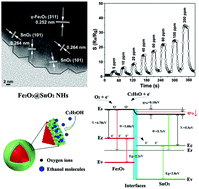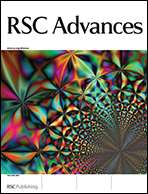Construction of core–shell Fe2O3@SnO2 nanohybrids for gas sensors by a simple flame-assisted spray process†
Abstract
In this paper, core–shell Fe2O3@SnO2 nanohybrids were fabricated via a simple flame-assisted spray pyrolysis (FASP) process. A shell layer composed of SnO2 nanocrystals (8–10 nm) was grown in situ on the pristine Fe2O3 nanoparticles, with a tailored thickness ranging from 6–20 nm. The construction of such an intriguing structure thus provided a rational and efficient combination of two kinds of gas sensitive materials, resulting in a remarkably enhanced sensing ability (Ra/Rg) and good selectivity in the detection of 22.8 to 100 ppm ethanol vapor at 300 °C, compared to the corresponding pure Fe2O3 and SnO2 materials synthesized by FASP. This enhancement can be mainly attributed to the synergistic effects arising from the presence of both of these materials, i.e. the change of the heterojunction barrier height at the Fe2O3/SnO2 interface. In addition, the in situ flame coating process provides a promising and versatile choice for the synthesis of core–shell nanostructures with multifunctional compositions.


 Please wait while we load your content...
Please wait while we load your content...